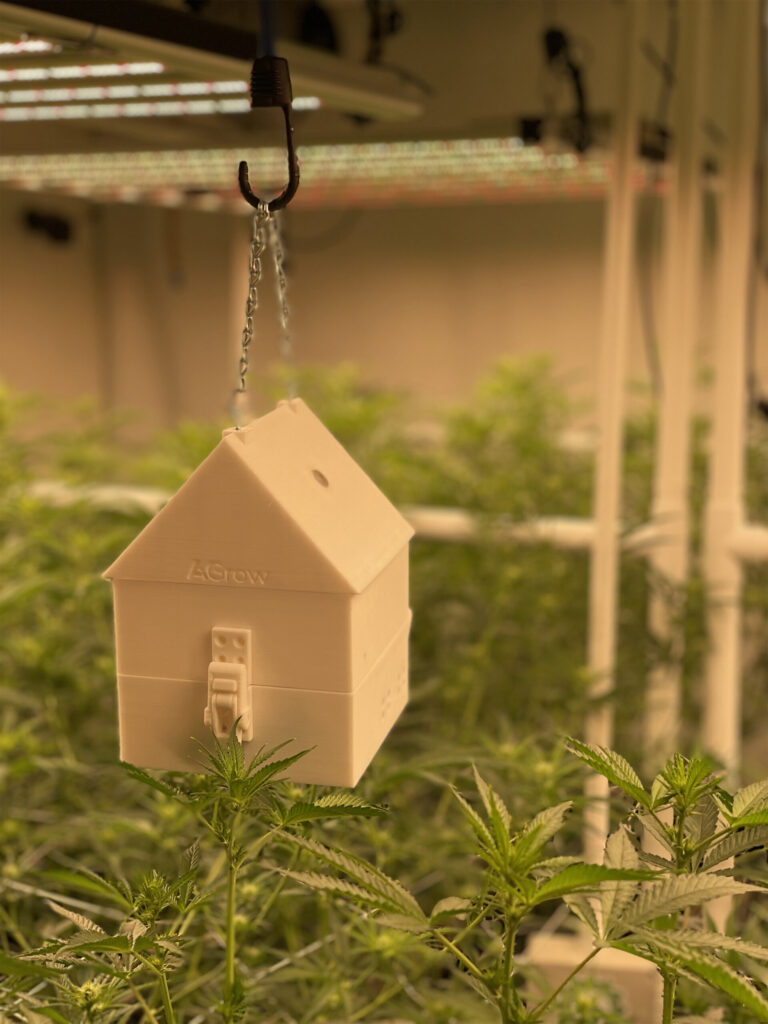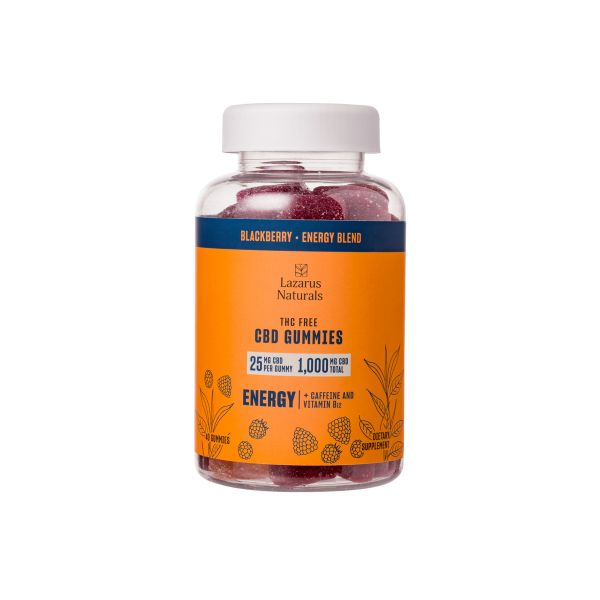Welcome to our Lazarus Naturals gummy review!
These 25mg CBD gummies—enhanced with L-theanine, caffeine, and more—aim for a clean energy boost that steers around the pitfalls of energy drinks while providing the wellness-affirming benefits of CBD.
Where they perhaps miss a bit of potential in the supporting cannabinoids department (by the way, they’re THC free), these gummies open up completely new avenues for CBD users looking for a product they can use earlier in the day to soldier through a busy schedule.
Our team found the gummies to be effective and tasty in this regard—here’s everything else we learned in our experience with Lazarus Naturals CBD Energy Gummies.
Table of Contents
- Pros and Cons
- Quality
- Concentration
- Value
- Packaging
- Ingredients
- Flavor and Texture
- Effectiveness
- Conclusion
Lazarus Naturals CBD Energy Gummies
Concentration
25mg CBD x 40 gummies (1,000mg total)
Ingredients
Organic Tapioca Syrup, Sucrose, Water, Organic Blackberry Juice Concentrate, Pectin, Organic Pear Juice Concentrate, Organic Clarified Lemon Juice Concentrate, Yuzu Flavor, Yuzu Juice, CBD Isolate, L-Theanine, Sodium Citrate, Blackberry Flavor, Taste Modifier (Propylene Glycol, Glycerine, Natural Flavor, Monoammoniated Glycyrrhizin), Natural Masking Flavor Powder (Salt, Maltodextrin, Natural Flavors, Food Starch Modified, Silicon Dioxide), Caffeine, Vitamin B12
Coupon Code
Use code CBDINSIDER for 10% off
Pros and Cons
Let’s start with the pros
- Great taste and texture
- Superior value
- Sustained energy boost
- Quality sourcing, manufacturing, and testing standards
And now the cons
- Higher added sugar content per gummy
- No supporting cannabinoids
- One concentration/size offered
Quality
Lazarus Naturals sources their hemp from partner farmers in Oregon, all of which are registered with the state department of agriculture.
They use organic methods to grow the hemp and employ multiple rounds of testing (pre-harvest and afterwards) to ensure the safety, quality, and potency of their products.
Lazarus Naturals hemp products are extracted using ethanol, which is considered the gold standard of the hemp industry alongside CO2 for its safety and efficiency.
Possibly the greatest quality differentiator at Lazarus is their flower-only extraction—as the flower is the most cannabinoid- and terpene-dense part of the hemp plant—which the majority of CBD brands still don’t do.
Regarding our review of the CBD Energy Gummies specifically, the savvy formulation (incorporating adaptogens and nootropics) reflects a high-level of understanding of the synergy between the CBD and other enhancers.
Overall, Lazarus Naturals as a company and their CBD Energy Gummies make a solid showing on the quality front, sticking stubbornly to industry gold standards in several areas of operation.
Concentration
Our Lazarus Naturals CBD Energy Gummies come in a single concentration and size: 25 milligrams a gummy at 40 gummies, providing a total of 1,000mg of CBD.
The good news as far as the lab test for these gummies is concerned is that there were no measurable amounts of pesticides, microbes, residual solvents (other than ethanol), or other contaminants.
However, if you’re looking for a harder-hitting CBD gummy that synergizes the cannabinoid with THC and/or other cannabinoids like CBG, CBN, etc., this may not meet your desired potency level as far as the hemp extract is concerned, since no supporting cannabinoids were detected.
Of course, the caffeine and L-theanine provide an entirely new use for this product, so if you’re more interested in a focused energy boost that doesn’t feel so jittery, this is the ideal formulation.
Either way, the concentrations on the lab report match the label, and 25mg per gummy is a solid step up from the slew of brands that infuse only 10mg or 15mg per gummy.
Value
Lazarus Naturals has long led the field of top-tier CBD brands when it comes to value, and this case is no different.
Their CBD Energy Gummies cost $38 on the Lazarus Naturals website, which reduces to $0.04/mg.
Considering this price beats many non-targeted CBD oil tinctures out there, which are considerably cheaper, it’s safe to say these are the cheapest or close to it when it comes to CBD gummies from reputable brands.
As for product quality relative to value, the lack of supporting cannabinoids is largely offset by the enhancement with focus-boosting compounds, so $0.04/mg remains an excellent value for a widely trusted brand.
Packaging
Our Lazarus Naturals CBD Energy Gummies arrived in a clear plastic bottle with a threaded lid.
The label provided a blurb about the brand, certifications (B Corp, vegan, gluten free, etc.), use instructions, supplement facts, ingredients, and more.
The containers were durable and easy to use—wide mouth helps—throughout our entire use of the product..
Finally, the label featured a QR code that leads you to the certificate of analysis from the lab test.
Overall, the packaging and labeling were consistent with every top-tier brand we have reviewed, with no major issues noted.
Ingredients
Here is the ingredient list for Lazarus Naturals CBD Energy Gummies:
Organic Tapioca Syrup, Sucrose, Water, Organic Blackberry Juice Concentrate, Pectin, Organic Pear Juice Concentrate, Organic Clarified Lemon Juice Concentrate, Yuzu Flavor, Yuzu Juice, CBD Isolate, L-Theanine, Sodium Citrate, Blackberry Flavor, Taste Modifier (Propylene Glycol, Glycerine, Natural Flavor, Monoammoniated Glycyrrhizin), Natural Masking Flavor Powder (Salt, Maltodextrin, Natural Flavors, Food Starch Modified, Silicon Dioxide), Caffeine, Vitamin B12.
Organic sweeteners and juice are great to see, as is the complete lack of harsh additives, but 4g of added sugar is on the higher side.
Most gummies range between 2-3g of added sugar, and are still very sweet at that level, so we will count the sugar content as the one knock against the formulation.
Otherwise, the clean ingredients paired with savvy additions like L-theanine, vitamin B12, and caffeine for energy and focus make for a very strong ingredient list.
Flavor and Texture
Thanks to real blackberry juice and flavoring, these gummies actually tasted like blackberries, and were neither too tart nor too sweet.
As for how effectively the flavoring covered up the bitter undertones from the natural hemp taste, this gummy was moderately above average, leaving nothing but a mild aftertaste.
The texture was consistent with most gummies we’ve reviewed, landing in the middle of the chewy (versus hard) spectrum.
The well-balanced flavor and texture made it easy to take 2-3 at a time.
Overall, we enjoyed both the flavor and texture of these Lazarus Natural CBD Energy Gummies, and have no major concerns to offer.
Effectiveness
Similar to how CBD can significantly offset the effects of THC, the CBD (and vitamin B) in this case helped to focus the caffeine rush for a more productive, sustainable, and less jittery burst of energy that lasted for several hours after taking 2-3 gummies.
If you’re looking to get into a “flow state” for several hours without feeling completely zapped afterwards, these gummies offer a gentle alternative to energy drinks and other less carefully formulated alternatives.
We also noticed, albeit to a lesser extent, some of the other characteristic benefits of CBD when using this product, including elevated mood and relief from minor discomfort.
Overall, we were pleased with the effectiveness of these Lazarus Naturals CBD Energy Gummies, and at 25mg a piece, many people will be able to find the right balance at just one or two gummies.
Lazarus Naturals CBD Energy Gummies
Concentration
25mg CBD x 40 gummies (1,000mg total)
Ingredients
Organic Tapioca Syrup, Sucrose, Water, Organic Blackberry Juice Concentrate, Pectin, Organic Pear Juice Concentrate, Organic Clarified Lemon Juice Concentrate, Yuzu Flavor, Yuzu Juice, CBD Isolate, L-Theanine, Sodium Citrate, Blackberry Flavor, Taste Modifier (Propylene Glycol, Glycerine, Natural Flavor, Monoammoniated Glycyrrhizin), Natural Masking Flavor Powder (Salt, Maltodextrin, Natural Flavors, Food Starch Modified, Silicon Dioxide), Caffeine, Vitamin B12.
Coupon Code
Use code CBDINSIDER for 10% off
Conclusion
Lazarus Naturals CBD Energy gummies are a tasty, effective, and intelligently formulated option for anyone looking to calmly power through long work days or other intensive tasks.
As expected, these gummies are priced to lead the market, and the integrity-driven sourcing and manufacturing practices of Lazarus Naturals helps to build trust around this product and the rest of their catalog.
The gummies were just chewy enough, tasted great, and made good on their promise to provide sustained energy without the jitters or the crash.
We’d like to see the added sugar content come down, but the decent concentration of 25mg/gummy helps to somewhat mitigate that issue.
We will continue to recommend these Lazarus Naturals CBD Energy Gummies to anyone looking for a focused burst of energy along with the other benefits this hard-working cannabinoid can provide—see our latest Lazarus Naturals Coupon here.
via
The CBD Insider https://thecbdinsider.com/review/lazarus-naturals-gummies-review/#utm_source=rss&utm_medium=rss&utm_campaign=lazarus-naturals-gummies-review
















